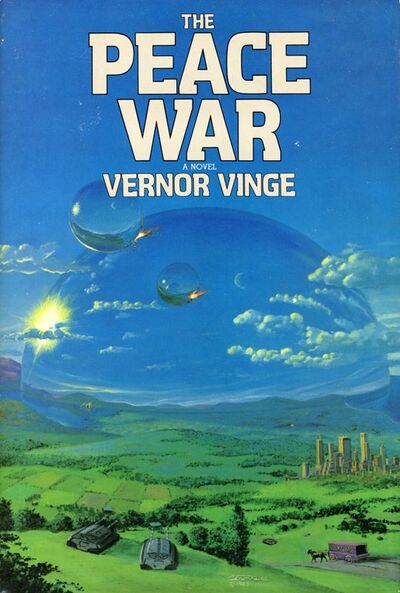Baby, It’s Timeless
The Peace War (Realtime, volume 1)
By Vernor Vinge

12 Dec, 2019
1984’s The Peace War is the first installment in Vernor Vinge’s Realtime series.
Astronauts Allison Parker, Angus Quiller, and Fred Torres were away from Earth, having been dispatched on a top-secret reconnaissance mission. They return to a planet utterly transformed in the interval between one heartbeat and the next.
The Peace War broke out when mysterious bobbles, impenetrable force-fields, encased whole cities and military sites. In the chaos that followed, ICBMs were launched and themselves bobbled. War and plagues swept across the planet. The human population fell by more than ninety percent.
All large governments but one vanished in the aftermath, replaced by anarchy, feudalism, and fascist statelets. The one remaining government is the soi-disant Peace Authority, the organization that unleashed the bobbles in the first place. The Peace Authority functions as an utterly minimalist world government; its stated goal is to prevent anyone from redeveloping any advanced technology that could threaten the human species. Violators of Peace Authority bans are bobbled. Anything else goes.
As far as the world knows, bobbles are eternal (though those bobbled will live only as long as it takes bobbled air to run out). And then…
Fifty years later, there’s a sudden nuclear detonation near Tucson. The Peace Authority’s explains: bobbles do not last forever. When the bobble around the incoming Soviet ICBM popped, the nuclear fireball had not yet cooled. Too bad for Tucson.
The Peace Authority did not invent bobbles and they do not understand them. Bobbles are not force bubbles. They are stasis fields trapping whatever is inside, frozen in an instant of time, for as long as the bobble lasts. This seems to be fifty years, more or less. Over the next few years, millions of people thought long dead will reappear. Astronaut Allison Parker1, for one; her bobbled shuttle has just appeared in the Californian impact crater where it has been frozen since the War.
Paul Hoehler understands the science behind the bobble. No surprise here; he’s the genius who invented the device. It was stolen by his boss, Avery, who saw it as a means to conquer the world. Paul escaped Avery and survived the Peace War. Now he and his fellow Tinkers are ready to free the world.
~oOo~
I would rank the books in the Realtime series in this order, from least dire to most dire: Marooned in Realtime, The Peace War, and the novelette The Ungoverned. IMHO, The Peace War isn’t all that good, but it’s leagues better than the libertarian tosh that is The Ungoverned.
The Peace War reminded me of Kevin O’Donnell, Jr.’s extremely obscure 1982 novel War of Oblivion. I wonder if Vinge had read this book and if it was in the back of his mind when he wrote The Peace War.
I see blank looks. Don’t feel bad; O’Donnell’s novel had one English edition and is so unknown it’s not listed on Goodreads and has no reviews on Librarything. Like The Peace War, War of Oblivion imagines a radical new technology that casts its targets into a timeless domain2. As I recall, O’Donnell’s treatment of the consequences of a Make-It-Go-Away device when wielded by well-meaning libertarians against the nasty statists was a bit more nuanced3 than Vinge’s, which makes me regret it’s not the O’Donnell novel I am reviewing.
Bobbles, a spherical stasis field with a pre-set duration, get centre stage in this book, but … the real conceit around which the book coheres is the Singularity, which Vinge popularized in this essay some years after writing The Peace War. Avery and his allies justified killing off civilization and most of humans on the grounds that accelerating technological progress would soon hand some group the ability to annihilate all humanity. To prevent that, the Peace Authority did their best to stop progress dead by annihilating most humans.
In SF, killing off billions of people isn’t always the sign of villainy — it often is something the good guys do — but stopping progress for whatever reason generally is. It’s not surprising the Peace Authority are the bad guys in this. They are so unsubtle in their villainy that even steadfast Peace Authority field agent Della Lu begins to wonder about the skulls on the Peace Authority caps.
This book was first serialized in the Stanley Schmidt-era Analog.

It delivers everything you would expect: flat characters, a stock setting, libertarian good guys rebelling against a malevolent world government whose conquest of the world doesn’t really pass the sniff test, a plot where it’s clear which side will win, and of course a few mildly racist bits. It’s a dull book, which may be why I didn’t finish reading the serial back when I still read Analog.
Your tastes may vary, of course.
The Peace War is available here (Amazon US), here (Amazon Canada), here (Amazon UK), and here (Chapters-Indigo).
1: Her companions, being surplus to plot needs, do not long survive the 21stcentury.
2: The O’Donnell device manages to be even more obnoxious than the bobbles in its immediate effects. Not only does everything in the zone of affect get tucked away in a pocket universe, all biological memories relating to the contents vanish as well. This is very confusing for people left behind. When some well-meaning extremist removes Washington DC, everyone forgets it ever existed. The effects of Washington DC governmental actions remain, which means that people are left with what appear to be random, causeless effects.
3: However good your motives, you will find that there’s a downside to removing huge chunks of a nation’s infrastructure.
